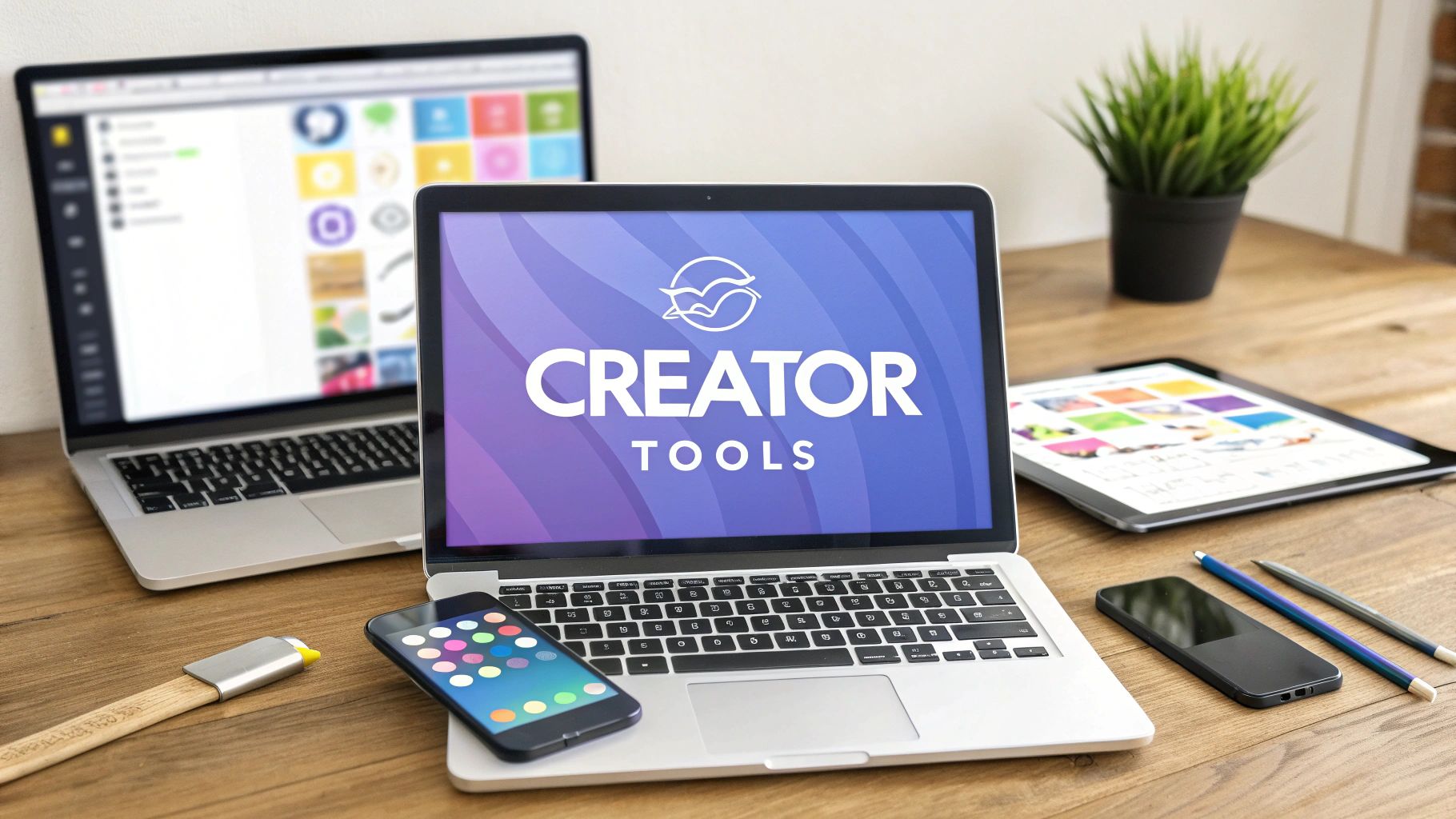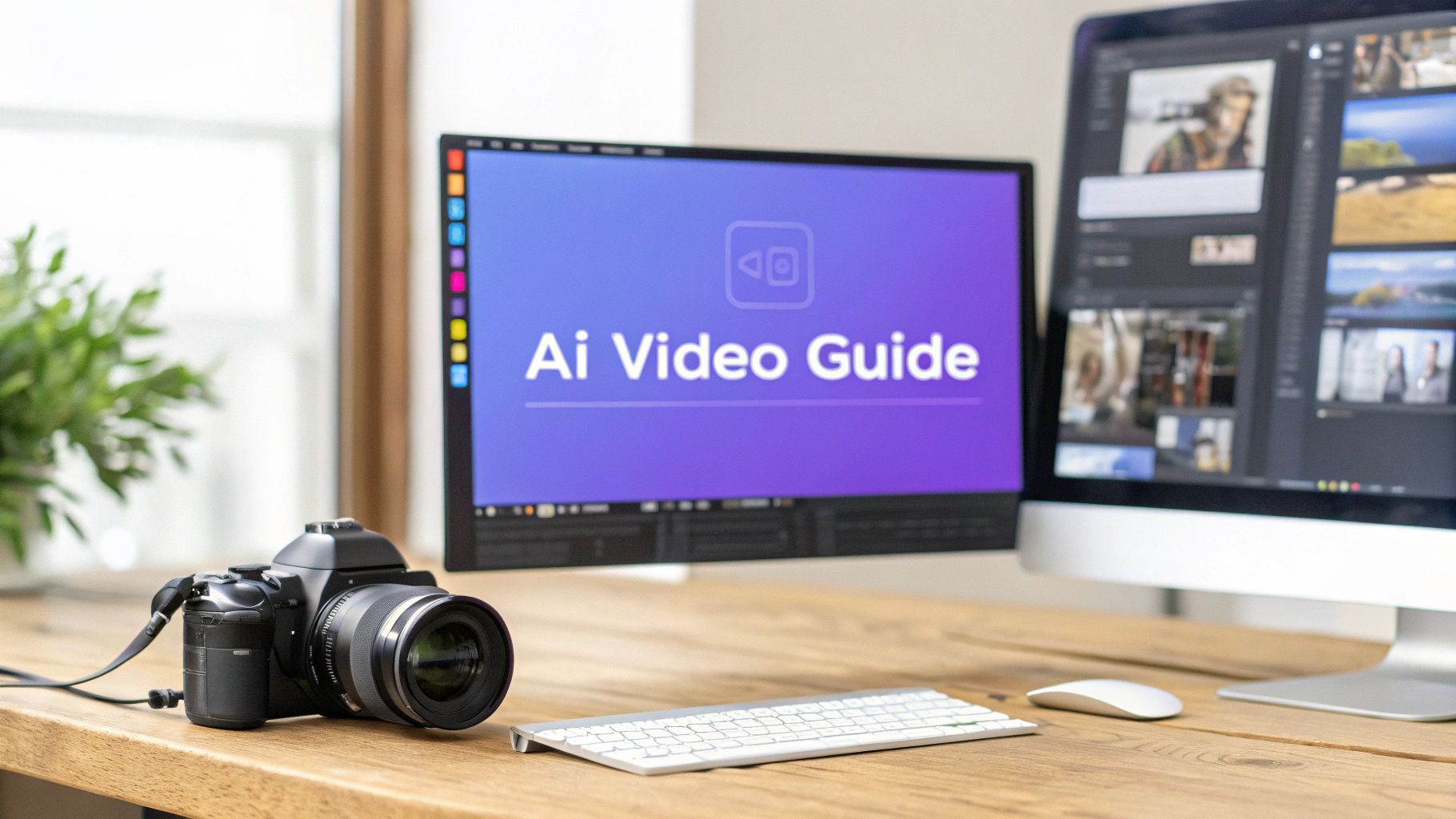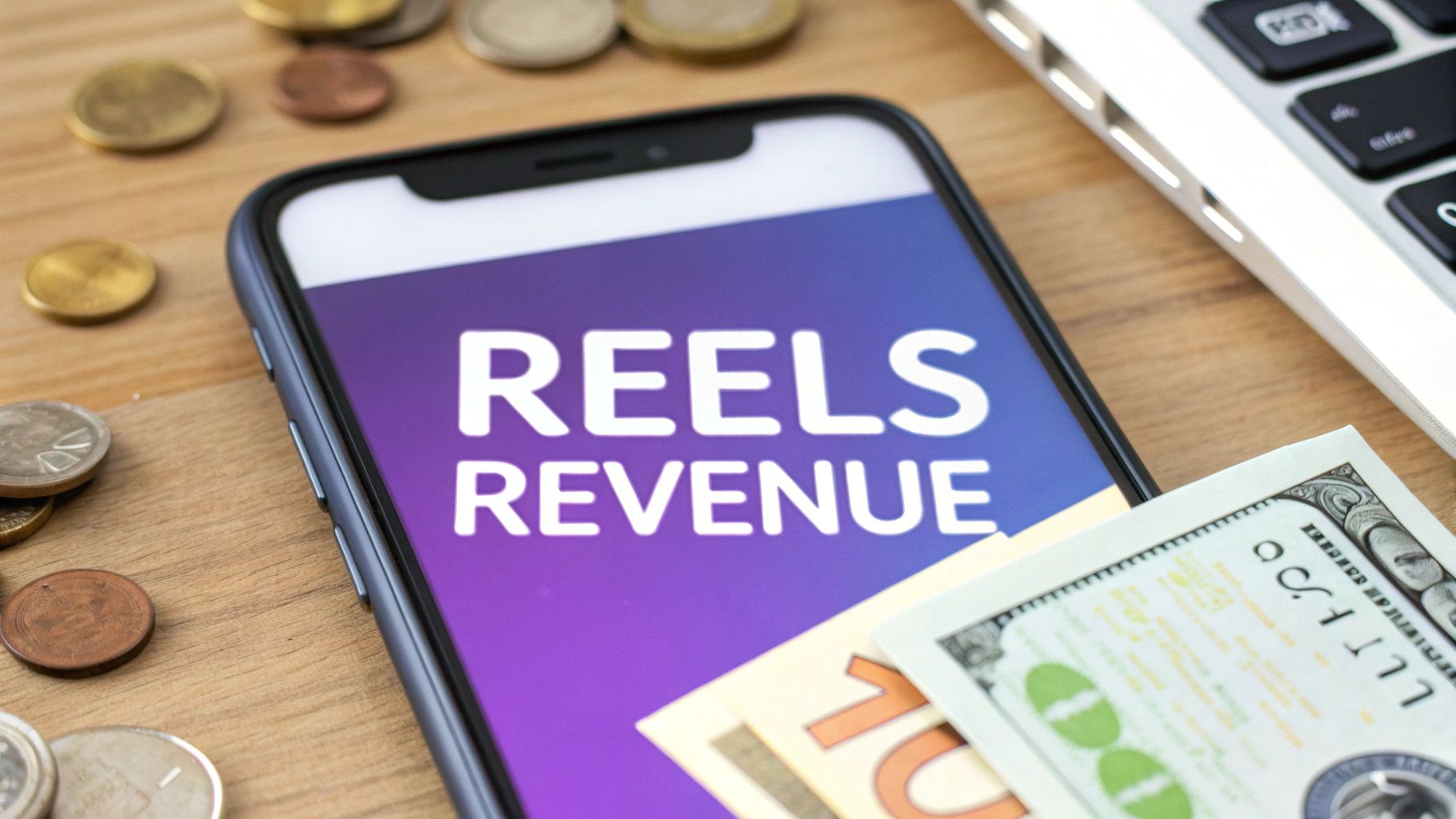Want to create social media content that actually gets noticed? The secret isn't just about flashy graphics or clever captions. It starts with a solid plan that's built before you even think about hitting "publish."
This foundational work is what separates content that gets lost in the scroll from content that genuinely connects with people and builds a loyal following. It's about being intentional with everything you post.
Building Your Content Strategy From the Ground Up
Let's be honest: great social media doesn't just happen. It's the result of a deliberate, well-researched strategy. Before you jump into creating, you need to lay the groundwork by figuring out who you're talking to, what you want to achieve, and what everyone else in your space is doing.
This initial planning ensures every single piece of content has a clear purpose and a direct path to engaging your followers.
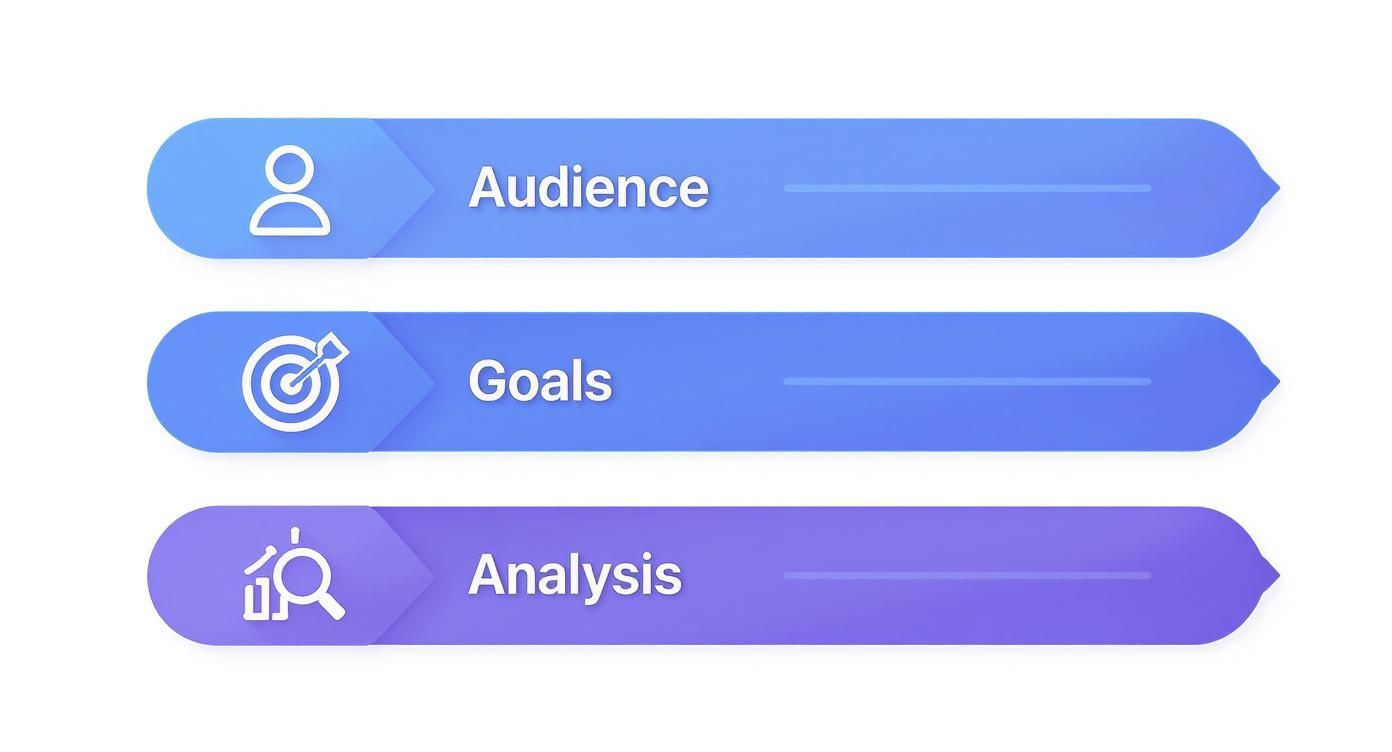
It all starts with getting to know your audience on a deeper level. This understanding will inform every single decision you make from here on out.
Before diving into the specifics of audience personas and goal-setting, let's look at the big picture. These are the core components you need to get right.
Core Components of a Winning Content Strategy
| Strategic Pillar | Key Action | Why It Matters for Engagement |
|---|---|---|
| Audience Definition | Create detailed personas that go beyond basic demographics. | When people feel understood, they're far more likely to listen, interact, and trust you. |
| Goal Setting | Establish specific, measurable objectives (e.g., website clicks, brand mentions). | Clear goals prevent you from just "posting to post" and ensure your content serves a business purpose. |
| Competitive Analysis | Identify what your competitors are doing well—and what they're missing. | This helps you find gaps in the conversation and create content that stands out from the noise. |
With these pillars in place, you have a roadmap to guide your creative process and keep your efforts focused.
Understand Your Audience Deeply
Going beyond basic demographics like age and location is crucial. You need to create detailed audience personas, which are essentially character sketches of your ideal followers.
What keeps them up at night? What kind of humor do they love? Who are they already following for inspiration? Answering these questions helps you create content that feels like it was made just for them.
This personal touch is more important than ever. With 65.7% of the global population expected to be on social media by 2025, people are picky. They hop between an average of 6.84 different platforms each month, gravitating toward content that actually speaks to them—whether for news, connection, or just a good laugh.
Set Clear and Measurable Goals
Every piece of content you create needs a job. Are you trying to get your name out there and boost brand awareness? Drive traffic to your new blog post? Or are you focused on generating direct sales? Each of these goals requires a completely different approach.
A common mistake I see is creating content without a clear objective. Every post should be a small step toward a larger business goal. If a post doesn't support a goal, it's just noise.
For instance, if your goal is "brand awareness," you'll want to track metrics like reach and impressions. But if you're trying to "drive sales," you'll be laser-focused on link clicks and conversion rates.
Having a structured plan is key. Using something like a marketing campaign planning template can make all the difference in aligning your content with real, tangible outcomes. For a fantastic walkthrough on this, check out this guide to content strategy for social media.
Choosing Content Formats That Actually Work
Once you've got your strategy locked in, the next big question is... what do you actually post? This isn't about just chasing the latest trend. It’s about picking the right vehicle for your message so it genuinely connects with your audience. The format you choose can absolutely make or break your engagement.
The best choice isn't always what you'd expect. For years, the social media world has been chanting "video, video, video," but the real-world data tells a much more interesting story. As of 2025, while overall social media engagement has dipped across the big platforms, a classic format has made a surprising comeback. You can dive deeper into the numbers in this social media benchmark report.
The Surprising Power of Static Images
It’s almost ironic. While platforms like Instagram have been pushing video with everything they've got, it’s the humble static image that’s quietly started outperforming it. Believe it or not, static posts recently hit a higher average engagement rate of 6.2% compared to Reels at just 3.5%.
It’s a great reminder that a single, powerful image paired with a killer caption can stop someone’s scroll far more effectively than a half-baked video ever could.
Static images are perfect for things like:
- Making your products look incredible with high-quality photos.
- Sharing powerful quotes or bite-sized tips.
- Announcing big news or a sale in a clear, unmissable way.
Never underestimate the power of a stunning photo or a beautifully designed graphic. Sometimes, simple is better.
Mastering Short-Form Video
Of course, video isn't going anywhere—it's still a powerhouse. But succeeding with it means you have to get the nuances of each platform. A video that goes viral on TikTok could completely bomb on LinkedIn. You have to play by the unwritten rules of each space.
- TikTok: This is the land of trends, raw authenticity, and pure entertainment. Jump on trending audio and create content that feels like it belongs there, not like a polished ad.
- Instagram Reels: While it shares DNA with TikTok, Reels tends to favor more polished, aesthetically pleasing content. Think beautiful transitions, quick tutorials, and satisfying behind-the-scenes clips.
- YouTube Shorts: Viewers here are often coming from the main YouTube site, so they're already primed for educational or value-first content. Quick tips, interesting facts, or super-condensed versions of your long-form videos work wonders.
The secret to great video isn't a Hollywood budget—it’s delivering real value to the viewer. Your video needs to give them something worthwhile, whether it's a laugh, a new skill, or a sneak peek, within the first three seconds.
Beyond Single Posts: Carousels and Guides
If you want to provide more depth, you need to think beyond single images and short clips. Carousels and guides are fantastic for creating truly engaging social media content because they do one thing algorithms absolutely love: they keep people on your post longer.
A carousel post, whether on Instagram or LinkedIn, is like a mini-presentation. It lets you break down a big idea into easy-to-digest slides. You can use them to share a list of tips, tell a story one step at a time, or show off a product from every angle.
Mixing these formats keeps your feed fresh and gives your audience a reason to keep coming back. And to get the most out of every piece you create, it’s worth learning how to repurpose content effectively across all your different channels.
Crafting Stories and Visuals That Stop the Scroll
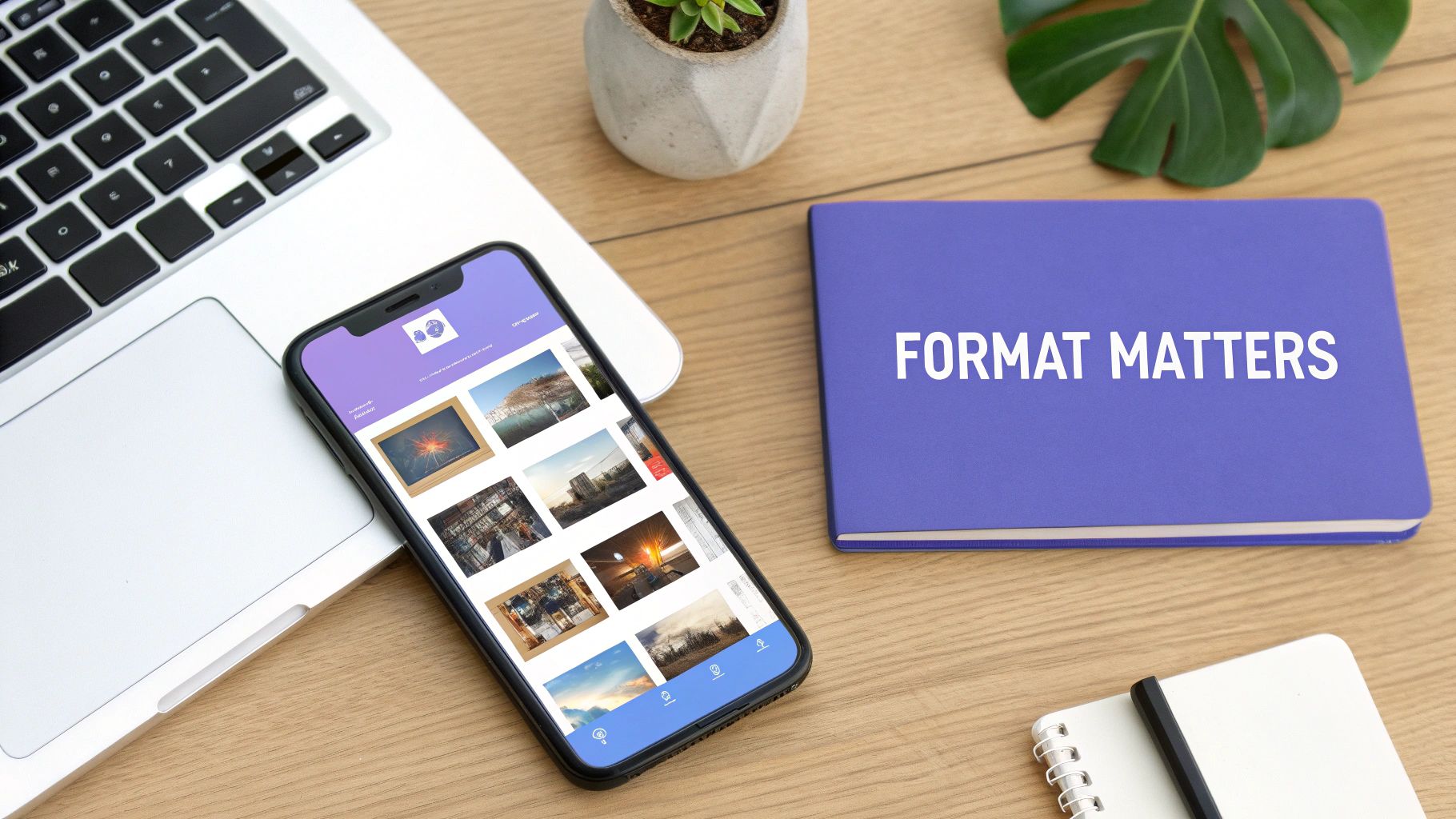
This is where all the planning pays off. You've got your strategy and you know what formats you're using. Now it’s time to actually create something that makes people pause their endless scrolling.
It’s not just about posting. It’s about weaving compelling words and striking visuals together to create a moment of connection in a sea of content.
Great storytelling on social media doesn’t mean writing a novel. It's about crafting captions that feel like a real conversation and creating video hooks that grab someone in the first three seconds. This is the secret sauce for making content people actually remember.
Writing Captions That Connect
Your caption is where you add context, personality, and a clear call to action. We need to move past the generic "What do you think?" and start real conversations.
Try sharing a surprising statistic, a moment of vulnerability, or a genuinely useful tip. The goal is to make your audience feel like they got something valuable from stopping to read. A killer caption can turn a simple photo into something truly memorable.
Don't just describe what's in the picture—tell the story behind it. A behind-the-scenes detail or a personal reflection is far more compelling than a basic description.
Here are a few ways I’ve seen this work really well:
- Share a Mini-Story: Frame your post with a clear beginning, middle, and end. Talk about a problem, how you tackled it, and what happened.
- Offer a Strong Opinion: A well-reasoned, bold take is a fantastic way to attract your people and spark a healthy debate. Just be ready to engage!
- Provide a Quick Tutorial: Break down a complicated process into a few simple, numbered steps right there in the caption. Easy to read, easy to save.
The Art of the Three-Second Hook
With video, those first few seconds are everything. You have a tiny window to convince someone to stick around. Your hook has to immediately answer the viewer's unspoken question: "Why should I watch this?"
A great hook often presents a relatable problem, asks a controversial question, or just shows a visually stunning opening shot. Don’t be afraid to test different opening lines to see what gets the best watch time. For a deeper dive, you can learn how to create attention-grabbing hooks with AI video tools and make this crucial step a whole lot easier.
Designing Visuals That Build Your Brand
Look, you don't need to be a graphic designer to create visuals that work. The real key here is consistency. Your visuals should be so distinctly you that people recognize your posts before they even see your name.
How do you get there? It comes down to a few simple things.
First, lock in a consistent color palette. Pick a handful of primary colors that match your brand’s vibe and use them relentlessly. Next, choose one or two readable fonts and stick with them for all your graphics. This alone will make everything look more cohesive and professional.
Finally, never compromise on quality. A blurry photo or a poorly lit video can make even the most brilliant message fall flat. Always aim for high-quality images and videos. It builds trust and helps create a strong brand identity that people actually connect with.
Using AI and Tools to Work Smarter, Not Harder

Trying to keep up with the constant demand for great content can feel like a never-ending marathon. That's where the right technology comes in. Think of smart tools as your support crew—they help you keep a steady pace so you don't burn out.
Integrating these tools isn't about being lazy; it's about being strategic. It’s how you free yourself from the tedious stuff and get back to what actually grows your brand: building real connections with your audience.
AI as Your Creative Assistant
Let's be real, artificial intelligence is no longer just a buzzword. It's a genuinely practical part of a creator's daily toolkit. Gone are the days of staring at a blinking cursor, wondering what to post next.
AI can be a fantastic brainstorming partner. Feeling stuck? Feed it your target audience persona and ask for a month's worth of content ideas. It can draft some initial captions, suggest a few punchy video hooks, or even outline a quick script to get you started.
The secret is to treat AI's output as a first draft, not the final product. It gets you 80% of the way there. Your job is to add the final 20%—your unique personality, your stories, and your brand's specific flavor.
This approach is a massive time-saver. It demolishes creative blocks and helps you stay consistent. If you're curious about what's out there, checking out some of the best AI tools for content creators can give you a great head start on building your tech stack.
Picking the Right AI Tools for the Job
Not all AI tools are created equal, and the "best" one really depends on what you're trying to accomplish. Here’s a quick breakdown of how different types of AI can fit into your social media workflow.
AI Content Tool Comparison for Social Media
A look at different AI tools and their best use cases for creating engaging social media content.
| Tool Category | Example Tools | Best For | Key Benefit |
|---|---|---|---|
| Generative Writing | Jasper, Copy.ai | Drafting captions, ad copy, and blog post ideas. | Overcoming writer's block and generating multiple variations quickly. |
| Video & Audio Editing | Descript, Opus Clip | Creating short-form videos from long-form content, adding subtitles. | Repurposing content efficiently and making videos more accessible. |
| Image Generation | Midjourney, DALL-E 3 | Creating unique graphics, backgrounds, or conceptual images. | Producing custom visuals without needing advanced design skills. |
| All-in-One Platforms | Sprout Social, Agorapulse | Idea generation, post optimization, and performance analysis. | Centralizing your entire content workflow from start to finish. |
Having a mix of these tools allows you to handle different parts of the content creation process without needing to be an expert in everything.
Essential Tools for a Streamlined Workflow
Beyond AI, a few other tools are non-negotiable for building a process that doesn't fall apart under pressure. These are the nuts and bolts of a well-run social media operation.
- Scheduling Platforms: I can't imagine my life without a scheduler. Tools like Buffer or Later let you batch your content and set it to post automatically. This means you can show up consistently without being glued to your phone all day.
- Content Calendars: Your content calendar is your command center. Whether it's a simple spreadsheet or a project in Notion, this is where you map out themes, track what's been posted, and keep everyone on the same page. No more last-minute scrambling.
- Analytics Dashboards: The native analytics on each platform are fine, but dedicated tools can pull all your data into one place. This gives you a bird's-eye view of what's actually resonating with your audience so you can double down on what works.
When you assemble a toolkit that covers ideation, scheduling, and analysis, you build a system that truly supports you. That's the key to scaling your content without sacrificing quality—or your sanity.
Adapting Your Content for Each Social Platform
Let's talk about one of the biggest mistakes I see brands make: posting the exact same thing everywhere. It’s a huge missed opportunity. Every social media platform has its own vibe, its own algorithm, and its own audience expecting something different. Learning how to create engaging social media content really means learning to speak the native language of each channel you’re on.
Think about it. You wouldn't give the same presentation at a formal business conference as you would at a casual meetup with friends, would you? The same idea applies here. When you tailor your message, you're showing your audience that you get them and the space they're in. That’s how you earn their attention and, more importantly, their trust.
LinkedIn: The Professional Powerhouse
LinkedIn is so much more than a digital resume these days. It's a genuine hub for industry news, deep-dive discussions, and real thought leadership. People on LinkedIn are looking for expertise, data-backed insights, and content that helps them grow in their careers. That's why educational, text-rich posts that kickstart a conversation among peers tend to do so well.
A perfect example of this is the boom in document posts—you know, those slick carousels made from PDFs. Instead of just a single image, you can walk your audience through a complex topic, share a compelling case study, or offer a step-by-step guide they can save. In fact, looking ahead to 2025, LinkedIn documents are pulling in a massive 37% engagement rate. This just goes to show how much the platform values authentic, value-packed content. If you want to dig deeper, you can explore more of these trends and get some in-depth social media engagement insights.
Instagram and TikTok: The Visual Storytellers
Now, let's flip the script. While LinkedIn is all business, Instagram and TikTok are driven by visuals, personality, and pure entertainment. That same core idea needs a complete makeover to land here.
Let's stick with that product launch example. On Instagram, you have so many creative avenues:
- A beautifully shot Reel showcasing your product in a real-world, aspirational setting.
- An Instagram Story with an interactive poll asking your followers which feature they're most hyped about.
- A carousel post that tells a behind-the-scenes story of how the product came to life.
Over on TikTok, the vibe is even more raw and tuned into what's trending right now. You could create a short, funny skit highlighting a problem your product solves, or maybe jump on a trending audio clip that fits your brand’s personality. Here, it’s all about authenticity and entertainment value.
The key takeaway is to stop broadcasting and start adapting. One core message can be the seed for a dozen different posts, each one perfectly crafted for the platform where it lives. This is how you build an audience that doesn't just see your content—they feel it.
X and Facebook: The Community Connectors
X (what we all still call Twitter) is built for speed and conversation. It’s the go-to place for short, punchy updates, asking your audience thought-provoking questions, and jumping into real-time industry chats. Your message needs to be concise and hit hard, fast.
Facebook, on the other hand, gives you a golden opportunity to build a real community, especially with Facebook Groups. Instead of just posting to your public page, you can create a more intimate space for your biggest fans. Think exclusive content, live Q&A sessions, and encouraging people to share their own experiences. Here, the content is less about being polished and more about fostering genuine participation and shared interests.
Your Social Media Content Questions, Answered
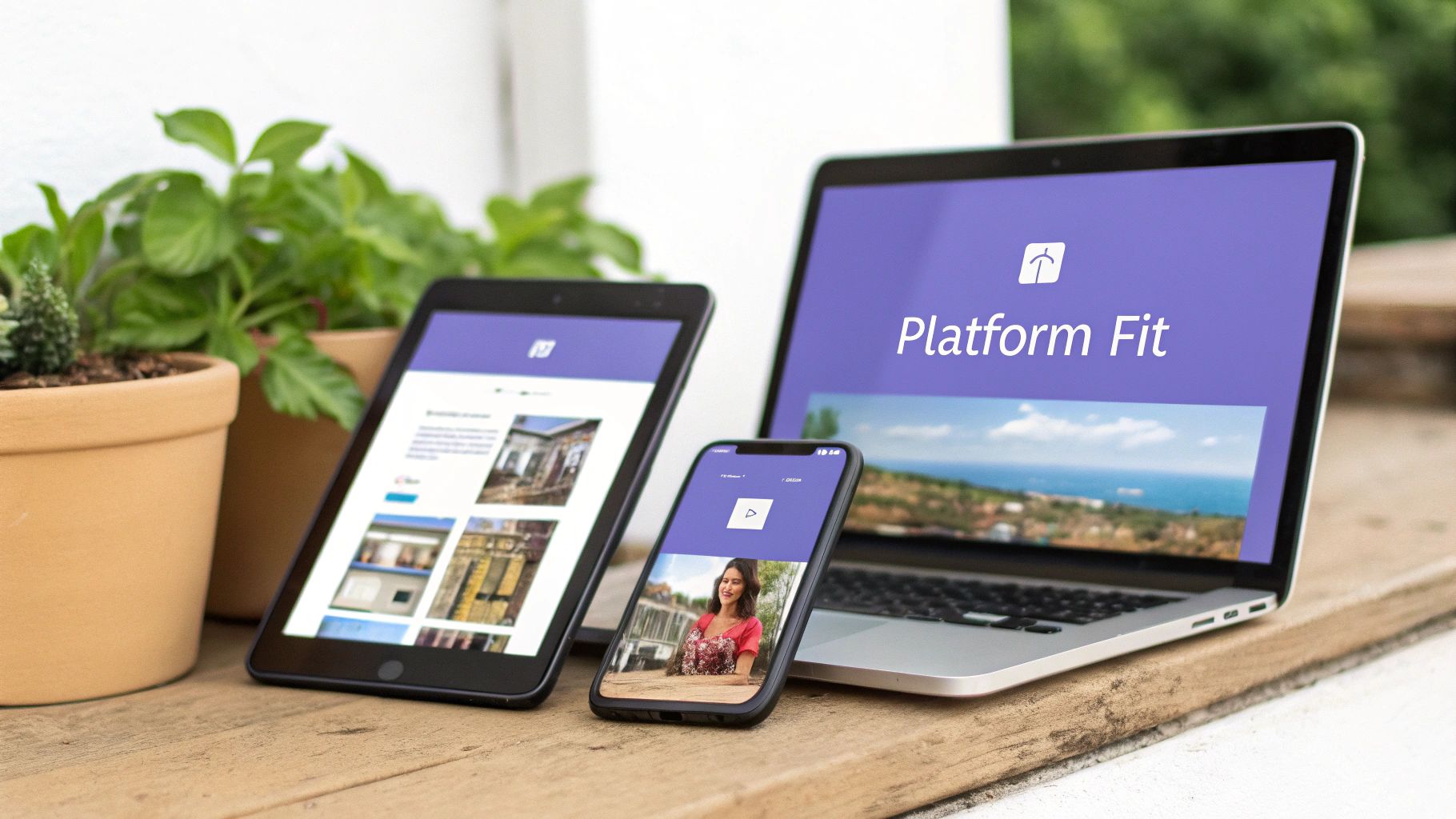
Even with a perfect plan, you're bound to run into questions once you're in the trenches of content creation. It happens to everyone. Getting those questions answered is what separates a strategy that stalls from one that succeeds. Let's dig into a few common sticking points I see all the time.
One of the first things people always ask is about how often they should be posting. Honestly, there’s no single right answer. The perfect posting cadence really comes down to the platform you're on and what your audience has come to expect from you.
The real goal isn't just volume. It's about keeping the quality high with every single post.
How Often Should I Post on Social Media?
I'll say it again and again: consistency will always beat frequency. It's far better to share three genuinely valuable posts a week than it is to push out seven rushed, low-impact ones just to hit a quota.
If you're looking for a baseline, here are some good starting points:
- Instagram or Facebook: Aim for 3-5 times per week.
- X (formerly Twitter): This is a faster-moving platform where multiple posts per day can work well.
- LinkedIn: Usually, 2-3 thoughtful posts per week is a solid target.
But these are just starting points. Your analytics are your best friend here. Dive in and see when your audience is actually online and engaging. From there, don't be afraid to experiment a little. Try different schedules and see what actually moves the needle for your brand.
The accounts that people truly connect with don't just post often; they post consistently well. Your audience learns to look forward to your content when they know it will always be worth their time, whether that's daily or just a few times a week.
How Do I Measure Real Engagement?
Likes are great for a quick ego boost, but they don't really tell you much. To figure out if your content is truly hitting the mark, you have to look deeper at the metrics that show people are taking action.
I always tell my clients to focus on these KPIs:
- Comments: Are people actually starting conversations? Are they asking questions or sharing their own take? That’s gold.
- Shares: Is your content so good that people feel compelled to show it to their own network? That's a huge win.
- Saves: This is a big one. Is your post so useful that someone wants to bookmark it and come back to it later?
For video, watch time is everything. And if your post has a link, the Click-Through Rate (CTR) tells you if your message was compelling enough to get that click. These are the metrics that give you a real, unfiltered picture of what your audience actually cares about.
How Can I Create Quality Content on a Small Budget?
You really don't need a Hollywood budget to make great social media content. In fact, some of the most viral stuff out there was shot on a regular smartphone. The secret is to lean into authenticity and providing real value, not just flashy production.
Modern phones have incredible cameras that are more than capable of shooting high-quality photos and videos. Pair that with free or low-cost tools like Canva, and you've got a powerful design studio right at your fingertips.
Another great strategy is to tap into user-generated content (UGC). Run a contest or simply encourage your customers to share photos with your product—it’s authentic, effective, and builds community.
Ready to create stunning social videos without the high costs and complexity? Sprello gives you an all-in-one AI suite to produce high-converting social content and ads in minutes. Generate scripts, build storyboards, and access realistic AI avatars to bring your ideas to life. Learn more and start creating with Sprello today.

